SECTION A
Answer all questions in this section. Write the letter representing the most correct answer to each question in the box provided.
1. Which one of the following sets of events occurs in a person when feeling cold?
A. Blood capillaries constrict, hair rises and metabolic rate increases.
B. Hair lowers, blood capillaries dilate and metabolic rate decreases.
C. Metabolic rate increases, blood capillaries dilate and hair lowers.
D. Metabolic rate decreases, blood capillaries constrict and hair rises.
2. Which one of the following word equations summarizes the process of fermentation?
A. Glucose - Ethanol + carbon dioxide + water.
B. Glucose - lactic acid + energy + water.
C. Glucose - ethanol + carbon dioxide + energy.
D. Glucose - lactic acid + water + carbon dioxide.
3. The type of roots labelled Y in figure 1 is called.

A. Prop roots.
B. Lateral roots.
C. Clasping roots.
D. Adventitious roots.
4. What are the chances of parents who are carries of a gene for albinism, producing an albino child?
A. 25%
B. 50%
C. 75%
D. 100%
5. Which one of the following is the correct route taken by an impulse after it has left a relay neuron?
A. Synapse - sensory neuron - effectors.
B. Sensory neuron - synapse - effectors.
C. Synapse - motor neuron - effectors.
D. Sensory neuron - motor neuron - effectors.
6. Which one of the following is the mode of feeding of a mould?
A. Holozoic
B. Saprophytic.
C. Autotrophic.
D. Parasitic.
7. Which one of the following is a characteristic of sandy soils?
A. High retention.
B. High capillarity.
C. Low drainage.
D. Hugh porosity.
8. Which one of the following plant organs has a scattered arrangement of vascular bundles?
A. Root of a monocotyledonous plant.
B. Stem of a monocotyledonous plant.
C. Stem of a dicotyledonous plant
D. Root of a dicotyledonous plant.
9. In the colonization of a bare rock, the next most likely group of plants after the lichens are the
A. Grasses.
B. Mosses.
C. Shrubs.
D. Trees.
10. Which one of the following includes all the possible blood groups that can be possessed by the children from a marriage between mother heterozygous for blood group A and a father heterozygous for blood group B?
A. A and B
B. AB and O
C. A, B and O
D. A, B , AB and O
11. Which one of the following is a correct route taken by carbon dioxide from the body cells of an insect to the atmosphere?
A. Trachea - tracheoles - spiracles.
B. Spiracles - trachea - tracheoles.
C. Tracheoles - trachea - spiracles.
D. Spiracles - tracheoles - trachea.
12. In an experiment to find the proportion of air in soil, the following results were obtained.
Volume of soil =x cm3
Volume of water added to soil = 200 cm3
Volume of soil plus water after stirring = y cm3
Which one of the following expressions gives the volume of air in the soil samples?
A. Y - x cm3
B. (x + 200) - y cm3
C. Y - 200 cm3
D. Y - (x + 200) cm3
13. Which one of the following enzymes acts best at low pH?
A. Pepsin.
B. Peptidase.
C. Trypsin.
D. Lipase.
14. Figure 2. Shows the changes in the lactic acid concentration in the blood during and after exercise.
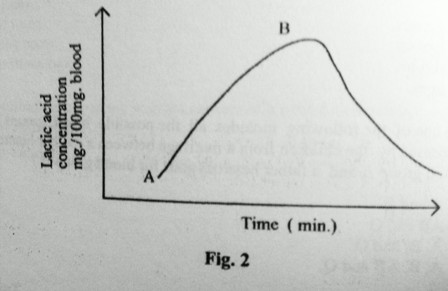
The correct explanation for what is occurring between points A and B is that
A. Breathing rate has increased.
B. Blood flow to the muscles has increased.
C. Oxygen supply to the muscles is less than the demand.
D. Oxygen supply to the muscles is excess.
15. Which of the following are characteristics of insect pollinated flowers?
A. Feathery stigmas, heavy pollen grains.
B. Sticky stigmas, heavy pollen grains.
C. Light pollen grains, dull coloured.
D. Long filaments, much pollen.
16. The part of the microscope used to make the image clear is the
A. Objective lens.
B. Eye piece.
C. Coarse adjustment.
D. Fine adjustment.
17. Which one the following glands become most active a person is frightened?
A. Thyroid gland.
B. Adrenal gland
C. Gonads
D. Pancreas
18. Figure 3. Shows a joint in a mammalian skeleton.
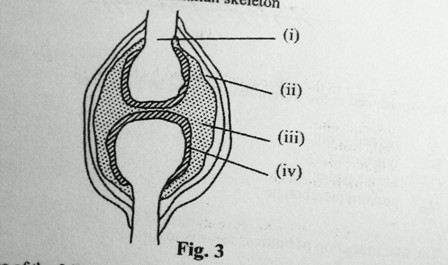
Which one of the following pairs consists of parts which reduce friction during movement in the joint?
A. I and II
B. I and III
C. II and III
D. III and Iv
19. Which one of the following correctly describes population density? The number of organisms
A. In a specified area.
B. Of a particular species in a species in a specified area.
C. Living either on land or water.
D. Which can interbreed and produce viable offspring.
20. Which one of the following is a form of sexual reproduction?
A. Binary fission
B. Fragmentation
C. Conjugation
D. Spore formation
21. Figure 4. Is an experimental set up to demonstrate photosynthesis.
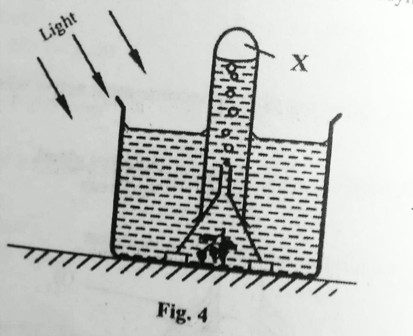
Gas X produced in the experiment is tested by the use of
A. Lighted splint
B. Lime water
C. Litmus paper
D. Sodium bicarbonate
22. The main function of buttress roots is to
A. Provide additional support.
B. Store food for the plant.
C. Enable the plant clasp firmly onto others
D. Store water for the plant.
23. The bacteria which convert ammonia into nitrates are called
A. Putrefying bacteria.
B. Nitrifying bacteria.
C. Denitrifying bacteria.
D. Nitrogen fixing bacteria.
24. Which one of the following is likely to occur if the osmotic pressure of the cell sap of the root hair is lower than that of the surrounding?
A. Plant wilts.
B. Cells of roots hair become turgid.
C. Rate of transpiration increases.
D. More water is absorbed.
25. Which one of the following foods is rich in iron?
A. Milk.
B. Cheese
C. Liver
D. Butter.
26. Which one of the following features of arthropods would be least important when constructing an identification key?
A. Presence or absence of antennae.
B. Number of body divisions.
C. Number of jointed appendages.
D. Body color.
27. Which one of the following conditions would lead to the highest transpiration rate?
A. High light intensity and low temperatures.
B. Low light intensity and high temperatures.
C. Low humidity and high temperatures.
D. High humidity and low temperatures.
28. Which one of the following parts of the kidney carries out the excretory function?
A. Cortex
B. Pelvis
C. Medulla
D. Nephron.
29. Which of the following events results into the formation of identical twins?
A. One egg released, fertilized and splits into two.
B. Two eggs released and each fertilized by a separate sperm.
C. One egg released and fertilized by two sperms.
D. One egg released splits and fertilized by separate sperms.
30. Which of the following diseases is not prevented by washing of hands and covering of food?
A. Cholera
B. Typhoid
C. Tapeworm infection
D. Dysentery
SECTION B
Answer all questions in this section. Answer must be written in the spaces proved.
31. A student carried out an experiment using the set up in figure 5. I n set R, bean seeds soaked in water were used. In S, boiled bean seeds sprinkled with a preservative were used, while in T, boiled bean seeds without the preservative were used.
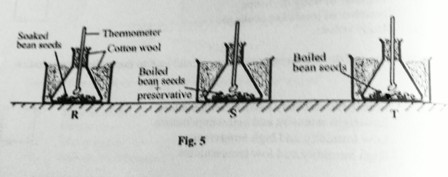
The temperature in each set was recorded for a week. The results obtained are shown in figure 6.
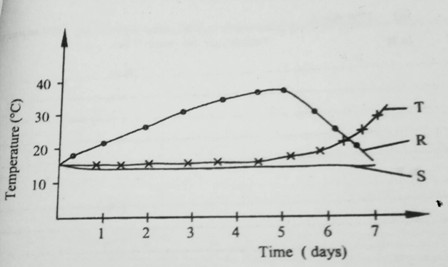
a) State the aim of the experiment.
b) Using the information provided, explain the changes in temperature in set R and T,
(i) From day 0 to day 5.
In R .....................................................................................................
In T ......................................................................................................
(ii) After day 5.
In R ...................................................................................................
In T ...................................................................................................
c) Explain why there was no significant change in temperature in S for the whole week.
d) Suggest one way the above set up could be improved for better results. Give a reason for the suggested improvement.
e) What other changes would occur in the composition of air in set up R and T during the experiment?
In R ............................................................................................................
In T ............................................................................................................
32. In a breeding experiment, when plants with red flowers were crossed, a total of 898 plants were produced out of which 325 had white flowers.
a) What was the recessive character? Give two reasons.
b) What was the genotype of the parents?
c) Using suitable symbols show the expected phenotypic and genotypic rations in the experiment.
d) Were the observed results in agreement with the laws of monohybrid inheritance? Show your working.
33. The following organisms live in a national part in Uganda: Bush rat, guinea fowl, hawk, grasshopper, Uganda kob and grass.
a) Show the feeding relationship that exists between these organisms.
b) What name is given to the feeding relationship in (a)?
c) Which organisms in the relationship are
(i) Primary produces?
(ii) Primary consumers?
(iii) Secondary consumers?
d) Suggest what would happen in the relationship if Uganda kobs were removed from the park.
SECTION C
Answer any two questions?
34. a) What is a balanced diet?
b) In which way is the ileum adapted for its function?
Outline the fate of food after absorption.
35. a) In what ways is nitrogen added and removed from the soil?
b) Give the importance of organic matter in the soil.
36. a) Describe how light, humidity and air movement affect the rate of transpiration in plants.
b) Describe an experiment to show that more transpiration occurs in the lower epidermis than the upper epidermis of a plant leaf.
37. a) Describe how the human body controls temperature.
b) What is the importance of having a constant body temperature?.
